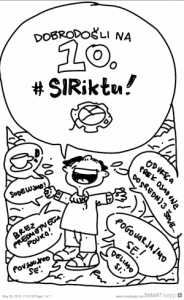Simona Samida Cerk, Osnovna šola Franceta Bevka
Modern literature teaching is based on the interpretation of literary texts by methodical system of school interpretation phases. The same principle should be applied when teaching integral texts – allowing pupils to perform simultaneous reception of visual and textual work. Kordigel Aberšek (2008) states, that we can achieve that by assuring everyone has access to the pictorial work while listening to the literary text. Children’s ability to reception should be further developed by reception of pictorial and literary work as well as with reception of text and art signals. Since the school does not provide enough copies of picture books for all pupils, teachers often read picture books in a way that all pupils sit in a crowded circle around teacher and the teacher is reading a literary text and showing illustrations from a picture book. In this way, the pupils are all the time fighting for a favourable position in order to listen and see the picture book. The reception of the literature is most of the time disturbed. Reception of the picture book can be improved by projecting pictorial work using ICT while reading the text out loud. Furthermore, other teaching activities involved in school interpretation phases can be liven up with the use of ICT tools such as JQuiz, JMATHC, JCLOSE, JMIX, JCross and others. In the introductory motivation pupils are animated by use of a variety of sensory activities, such as interesting excerpt of the work in the form of a radio play or a film. At the stage of interpretation of the youth literary work a variety of exercises made by ICT tools are used in order to check the understanding of the text, the acquisition and interpretation of new words and personal response to read literary text. Exercises are focused on open learning techniques, which allow individual participation of each pupil. Splitting them into smaller groups to forces them to actively think and deepen literary aesthetic experience and escalate their attention and focus in a picture book. The childs reception of the text significantly improves with his active participation in the educational process. With various entertaining inputs and the use of ICT we are strengthening pupil’s attention in all phases of school interpretation and achieving deeper thinking. In comparison with the conventional teaching is the teaching with ICT enriched, allows stronger reception of literary texts and leads to better performance in achieving of the Slovene curriculum objectives (Učni načrt za slovenščino, 2011).
